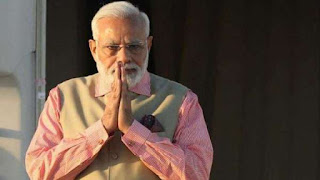Modi 2.0 & India economic challenges
Reviving
the economy,
The
first challenge!
Right
with the Modi returned with version 2.0, India Ratings and Research (Ind-Ra)
inked up: All Eyes on New Government to Revive Economic Growth.
Dr.
Sunil Kumar Sinha of Ind-Ra inks, after witnessing a quarterly slowdown during
1QFY17-1QFY18, India has witnessed another quarterly GDP growth slowdown fairly
quickly, according to India Ratings and Research (Ind-Ra). The agency expects
4QFY19 GDP growth to decelerate to 6.3% from 6.6% in 3QFY19. There would be
another four-quarter GDP slowdown, starting from 4QFY18. Thus, Ind-Ra expects
FY19 GDP growth to be 6.9% as against the FY19 advance estimate of 7.0% (FY18:
7.2%).
Clearly,
FY19 will be the second consecutive year of an economic slowdown in India.
Arresting the slowdown and reviving the economy will be the first challenge for
the new government. Policy prescription will require a granular analysis of the
ills plaguing the economy. In Ind-Ra’s opinion, the new government will have to
devise and execute both short-term and medium-to-long-term measures to arrest
the slowdown.
While
cyclical challenges can be addressed through short-term measures, the need of
the hour is to address the structural challenges plaguing the Indian economy.
At the macro level, the revival of investment (1QFY18: 3.9%; 1QFY17: 15.0%),
the resolution of the credit freeze witnessed by the non-banking financial
sector and the worsening of the global trade environment (export growth:
1QFY18: 4.9%; 1QFY17: 3.6%) are the key challenges.
Although
little can be done with regard to the global trade environment, certainly a
more proactive policy intervention than hitherto followed could be pursued to
aggressively revive investment. In Ind-Ra’s opinion, such intervention should
be the top priority of the new central government. A step-up in government
capex is indeed needed; however, it may be insufficient to provide a fillip to
the sagging growth because general government capex accounts for only 12.0% of the
investment in the economy.
 Several
high-frequency indicators – automobile sales, rail freight, petroleum product
consumption, domestic air traffic and imports (non-oil, non-gold, non-silver,
and non-precious and semi-precious stones) – indicate a slowdown in
consumption, especially private consumption despite low inflation in the
economy.
Several
high-frequency indicators – automobile sales, rail freight, petroleum product
consumption, domestic air traffic and imports (non-oil, non-gold, non-silver,
and non-precious and semi-precious stones) – indicate a slowdown in
consumption, especially private consumption despite low inflation in the
economy.
The
consumer price index inflation declined to 2.46% in 4QFY19 from the average
9.67% for 1QFY13-4QFY14. No doubt a sustained low inflation aids an economy in
many ways, but it has a flip side too. It reduces the nominal rate of growth
and translates into low income growth, leading to a reduced aggregate demand in
the economy. This scenario is reflected in private final consumption
expenditure growth.
Nominal
GVA is the sum of EBIDTA and wages in the corporate balance sheet and indicates
how income generated by a corporate entity is shared between the two key
factors of production: capital (including land) and labour. Subdued nominal GVA
growth due to low inflation means subdued EBIDTA and wage growth impacting
consumption demand. Nominal GVA growth decelerated to 11.0% in 3QFY19 from the
average 13.5% growth for 1QFY13-4QFY14.
Even
more worrisome is the deceleration in the nominal GVA growth of agriculture and
allied activities to 2.0% in 3QFY19 from the average 14.1% for 1QFY13-4QFY14.
In Ind-Ra’s opinion, this sharp decline in the nominal GVA growth of
agriculture and allied activities has morphed into the ongoing rural distress.
The
revival of the growth in FY20 either through fiscal or monetary stimulus, will
not be easy for the new government. On the fiscal front, the headroom available
is quite limited in view of the fiscal deficit budgeted at 3.4% of GDP for
FY20.
Also,
financing fiscal deficit will be expensive in view of household sector
financial savings net of financial liabilities falling short of the net
government borrowings (centre, state and centre’s extra budgetary resources).
Despite two consecutive rate cuts by the RBI, the borrowing cost in the market
has remained at a relatively elevated level because of this shortfall.
A
slowdown in the growth of household savings has rendered deposit/investment
mobilisation by banks/non-banking financial companies expensive and the
transmission of the policy rate cut is not finding a quick resonance in the
financial market. Moreover, banks are struggling with high NPAs, while
non-banking financial companies face credit freeze.
Therefore,
Ind-Ra believes even monetary stimulus under the current situation may not be
able to do the desired trick.





Comments
Post a Comment